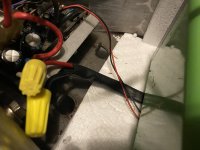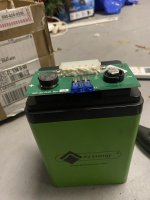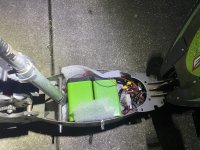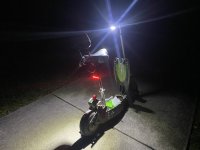Some thoughts (may not be related to your issue):
If this is about the green K2 battery posted previously, the battery says on it's recommended operating conditions that it only sustains 9.6A discharge current. Can do up to 25A for up to 30 seconds, but it doesn't say how often it can do that (how long you have to wait between bursts***).
It says it could do a *maximum* of 24A continuously, but it doesn't explain why it only recomends about a third of that--probably the cells sag in voltage a lot at the higher current and create a lot of heat. It also says it could do a maximum of 40A for a maximum of a two-second burst, and also doens't say how often it can handle this without damage. ***
How much current does your system draw? Your first post in this thread says you're looking for a battery that can handle "30A continuous load at 24v".
This battery shouldn't be made to do that even for a short period (it's not recommended, even though it's "max ratings" say it could do 24A continuous and 40A burst)
To stay within recommended limits (usually a good idea if you want to get the best results and performance from a part), you would need at least four of these batteries in parallel to do what you want. 9.6A continuous each, 30A / 9.6A = 3.125, so three won't do it; you'd still be overloading them continuously.
Two of them in parallel could do up to 50A for up to 30 seconds, so if you only need more than 9.6A x 2 = 19.2A periodically.
If you go by the *maximum* ratings, then two in parallel would be sufficient...but it's better not to use things at their max ratings.

*** If there was no limitation to the time between bursts, then it would be a continuous rating, because you could wait for one microsecond between them for instance, and effectively be continuously pulling the burst current, while still technically only pulling bursts...but it would probably still blow up or catch fire or whatever it's failure mode would be).
referenced image ( click for full size)
View attachment 346134
GoogleDocs OCR conversion of the image, may not be accurate; not proofread:
K2B24V10EB
Rechargeable Lithium Iren Phosphate Battery
25.6V 9.6Ah, 245.8Whr
Recommended Operating Conditions
Continuous Discharge | 9.6A
Pulse Discharge 30 seconds | 25A
Charge Current | ≤4.8A
Charge Voltage Cutoff | 29.2V
Discharge Voltage Cutoff | 20.0V
CAUTION:
Do NOT short circuit
Highest Operating Temperature | 60°C
Do NOT crush
Do NOT incinerate
Do NOT heat above 60°C
Do Not disassemble
Only use K2 approved charger
Lowest Operating Temperature | -20°C
Maximum Operating Conditions
Max Continuous Discharge | ≤24A
Max Pulse Discharge ≤2 Seconds | 40A
Max Charge Current | ≤9.6A
Max Charge Voltage Cutoff | 32.8V
Max Discharge Voltage Cutoff | 16.0V
Max in series | None (24V system)
Max in parallel | Unlimited
ENGINEERED IN THE USA
K2 Energy
www.k2battery.com







